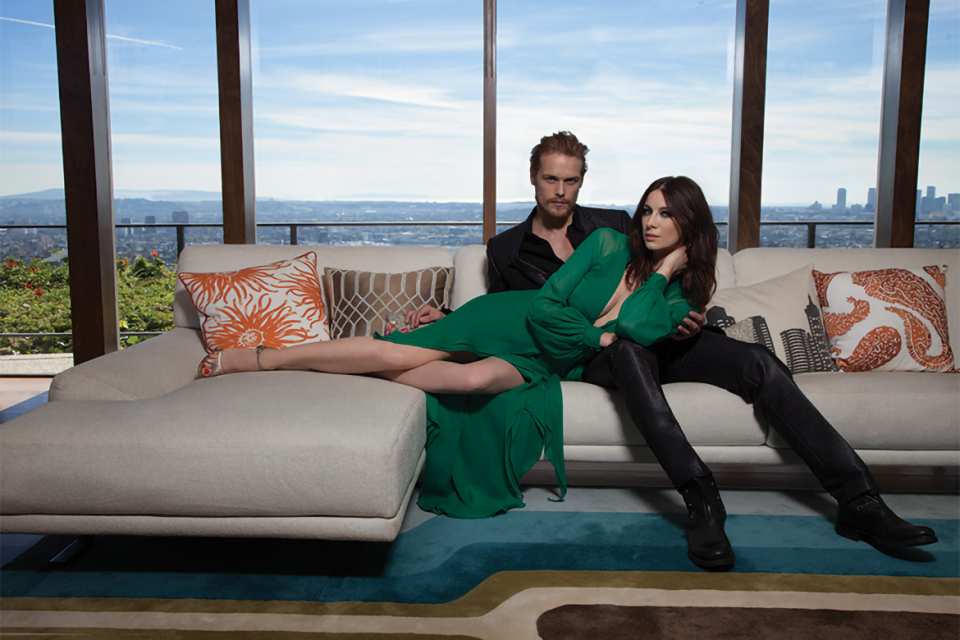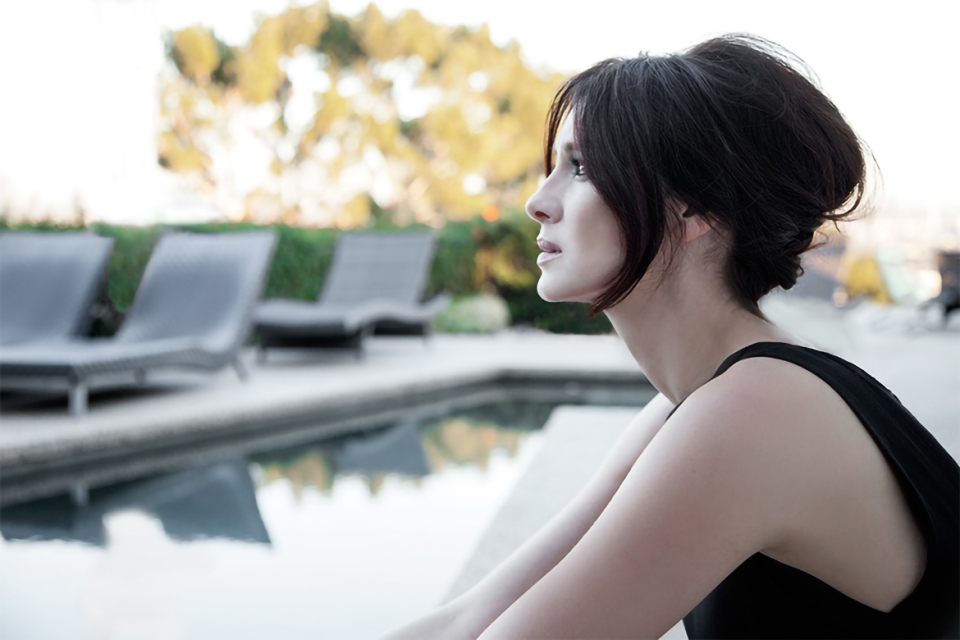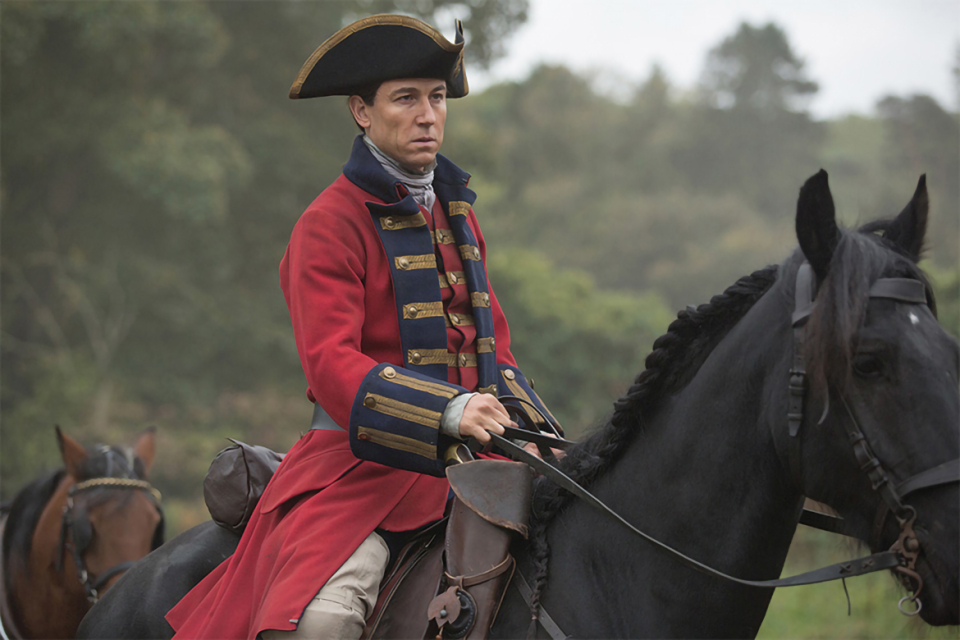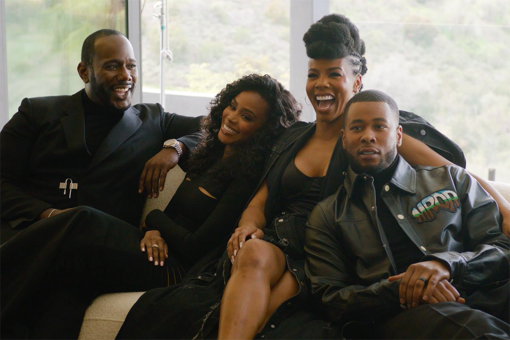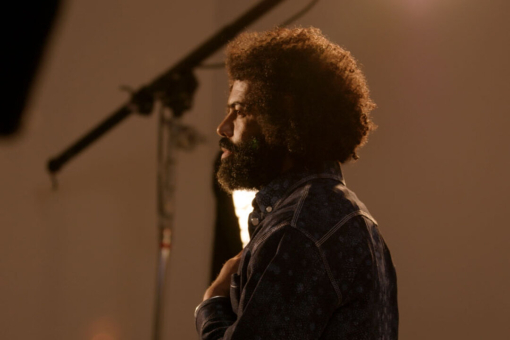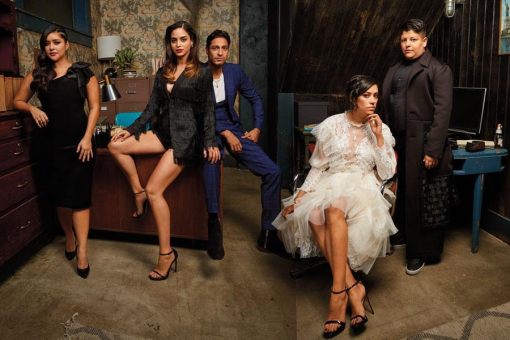On a windswept bluff in Scotland's rugged Perthshire county, at the foot of the forbidding mountains of the Southern Highlands, a biting mist swirls icy tendrils around newlyweds Jamie and Claire.
The couple — principal characters in Starz's new hit drama, Outlander — are out for a picnic, trying to come to terms with their marriage. The forced union is meant to keep Claire safe from British forces, who seek to arrest and imprison her as a Jacobite spy.
To look at them, you might not guess that they come from different worlds. But they do, quite literally, for she — until recently — was an English army nurse in World War II, 200 years in the future, who has traveled back in time to 18th-century Scotland. Jamie, meanwhile, is a rogue highlander very much in his own time, wanted by the British and, until his recent wedding night, a virgin to boot.
As they huddle together on that heather-strewn hillside, dark clouds loom on the horizon: the threat of war grows across England and Scotland, where allegiances between the clans, always a little uneasy, strain to breaking. Danger lurks in every dale and glen, as British troops and Scottish highlanders confront each other in fierce and violent clashes. And yet....
"I don't mean to imply you have some vast knowledge of men…but is it usual, what it is between us when I touch you?" Jamie asks, tentatively. "Is it always so between a man and a woman?"
Well, the winds of winter be damned. Clearly, in this part of Scotland, we're having a heat wave.
Based on the best-selling series of novels by Diana Gabaldon, Outlander has become the kind of tent-pole project that television executives dream about, thanks in no small part to lush locales and the hotter-than-hot chemistry between stars Caitriona Balfe and Sam Heughan.
"When we set out to do this series, our first goal for ourselves was to do no harm," says Starz CEO Chris Albrecht, referring to Gabaldon's literary legacy. "We wanted to make sure that the fans of the books felt we were doing justice to the story."
Executive producer and showrunner Ronald Moore (Star Trek: Deep Space Nine and Battlestar Galactica) shared that concern.
There was a lot at stake. Over the past two-plus decades, the books have sold more than 20 million copies and spawned tens of millions of fervent, mostly female fans around the globe. "When was the last time you completely lost your heart to a book?" enthuses one fan. Another gushes, "I am obsessed by Jamie and Claire."
Not surprising then, that it was two women — Moore's wife, costume designer Terry Dresbach, and his producing partner, Maril Davis (a coexecutive producer on the series) — who convinced him to read the first book in the series (there are eight in all). At the time, he was scouting for a new project, and the novel boasted something familiar from his days in space drama: specifically, time travel.
"It offered a lot, actually," Moore says. "It had action, romance, history, time travel… romance."
There's little doubt that the series skews heavily toward female viewers, but Albrecht says he's not concerned. He recalls his days as senior vice-president in charge of programming at HBO in 1998, when the cable channel introduced Sex and the City.
"That show started out with a strong female viewer base, but by the second or third season, a lot of these women were bringing their husbands and boyfriends to the show. And it worked."
Outlander, he believes, has plenty of elements that appeal to men. "It's sci-fi, it's historical fiction, and there are gnarly looking guys in kilts wielding swords."
Since the Starz programming philosophy differs from that of broadcast networks — "Premium cable isn't about selling eyeballs to advertisers," Albrecht notes — the ingredients for a hit are also different. "For us, it's more important to have something of this quality, with this kind of fan base that will endure for decades. That makes it a valuable product."
The series' value became evident very quickly, as fans of the novels started counting down in online forums to the show's August 2014 premiere. Including additional online platforms, on-demand, DVR and so on, more than 6.5 million watched the first episode, making Outlander the second-biggest premiere in Starz's history. (The channel's male-skewing pirate drama Black Sails attracted nearly 8.8 million viewers when it debuted in January 2014.)
Since then, Outlander's first eight episodes have averaged more than 5 million multi-platform views per episode. The first season was split; the second eight episodes began in April. In terms of social media, the show topped the Nielsens for Twitter conversation volume the day it premiered. A second season was announced within days.
Hoping to lure more men, Starz issued a mash-up promo video that joins scenes from Outlander with clips from Black Sails. "The focus will be to expand the audience as we move into the second season," Albrecht says.
While the romance between Jamie and Claire will always remain center stage, Moore and his staff of writers have amped up tensions between the Scottish clans and delved deep into the historical context of the second Jacobite rebellion. That's when clans loyal to Bonnie Prince Charlie and the House of Stuart, early monarchs of the kingdom of Scotland, tried to overthrow the British throne. They failed finally and bitterly at the Battle of Culloden.
There's also the storyline of Claire's husband, Frank. He's still back in the 1940s, a former MI6 operative searching desperately for his wife, who mysteriously vanished while visiting Scotland's mystical stone circle at Craigh na Dun. Tobias Menzies portrays both Frank and Frank's sadistic 18th-century ancestor, Black Jack Randall (cue some vivid scenes involving torture).
Moore says he doesn't spend a lot of time thinking about how the story skews to which demos; he concentrates on trying to stay as true to the books as possible.
"Doing a show that is an adaptation uses a surprisingly different muscle," he admits. "When we're in the writers' room, trying to crack a story, we don't have the option to throw it out. Rather, we put cards up on the board detailing the order of events in each book. And as we determine arcs, we've always got it in mind, 'How do we get back to the book?'"
As a boy, Sam Heughan grew up steeped in the lore of Scotland's highlands. His family is aligned with the powerful MacDonald clan — they share the same tartan — that at one time held the title of Lord of the Isles.
Born in the tiny town of New Galloway, 20 miles from the birthplace of renowned poet Robert Burns, Heughan lived with his mother on the grounds of an ancient castle. On a clear day, they could look across the Irish Sea to the Isle of Man.
It was a rural and rudimentary life; he was one of just four students in his class at school. By the time he reached secondary school, he and his mother had moved to Edinburgh.
"I think I knew I wanted to act from a young age,” Heughan says. “I just wasn't sure I could do it.” He studied at the Royal Scottish Academy of Music and Drama in Glasgow and got his first big break in 2009, cast as a drug dealer on the BBC soap opera Doctors. In 2011, he played a prince in the Hallmark Channel telefilm, A Princess for Christmas.
Caitriona Balfe was born in Dublin, Ireland, and grew up in the historic village of Tydavnet, a town whose beginnings date back to 2000 B.C. A tomboy and one of seven children, she was raised on a farm, where she'd sometimes have to milk the cows before school.
Balfe studied theater at the University of Ireland but, at the end of her first year, was offered the chance to model in Paris. "That seemed like a no-brainer, to move to Paris," she says. "But I ended up doing that quite a bit longer than I ever thought I would."
At the height of her modeling career, the willowy 5'10" Balfe was one of the top 20 models in the world, having done numerous couture shows for Dolce & Gabbana, Armani, Chanel, Marc Jacobs, et al. "But it always was in the back of my mind to go to New York, resume acting classes, see if I was any good," she says. Once she'd reached Gotham, she continued the journey, making a snap decision one day to pack up and move to Los Angeles.
For Outlander to succeed, the casting of Jamie and Claire was crucial. Readers had already known — and loved — the characters for a quarter century. "I always thought it would be much easier to find Claire," Starz's Albrecht says. "There are so many talented actresses out there. The role I was concerned about was Jamie."
But that's not how it worked out. Moore and the show's other executive producers (Jim Kohlberg and Andy Harries) saw Heughan early in the process and quickly knew they had found Jamie.
The actor says he was sent three scenes to learn — lengthy scenes involving a lot of dialogue taken almost directly from the books. "Ron flew over to the U.K., and I did a screen test," Heughan recalls. "I got an old friend from drama school to read with me. I had already read a lot of the first book, so I went in feeling like I knew Jamie."
Finding Claire would not prove as easy.
"We saw so many people for Claire — we were really getting late into the process," Albrecht notes. It was only after execs went back through the mountain of audition tapes that they zeroed in on Balfe. But, before any decisions were made, they knew they had to see Balfe and Heughan together, so they flew him in from the U.K.
"There was the most horrible road work on Pico Boulevard [in Los Angeles] that day," Balfe recalls. "I was 10 minutes late and I came running in, all sweaty. But Sam was the most calming, lovely gentleman. We got along very well."
Heughan recalls that fateful screen test: "It was a passionate scene between Jamie and Claire, where he is chastising her for running away and then getting caught [by British soldiers]. I had her in this huge bear hug, and she was really pissed off at me. As soon as Caitriona left, I think we all knew she was the one."
Claire is a demanding role. In the books she's front and center, narrating the story. While the character predates women's lib by decades, she is nonetheless a strong, independent and forthright person whom readers first meet in the bloody chaos of a WWII hospital tent.
In the TV series, Balfe appears in almost every scene, in costumes made of yards and yards of wool — and, given the show's penchant for authenticity, often out in the elements.
"There were days when it was raining so hard… and there was snow still on the ground," Balfe says with a small laugh. "You could barely see 10 feet in front of you and I'm thinking, 'Surely we can't be shooting out here today?'"
That lovely picnic on the windswept bluff? Tender, yes, but the crew kept having to stop filming to pour water off the plates.
Balfe says the role of Claire carries so much responsibility, she feels it has already changed her life. She can still walk under the radar in public — "People don't recognize me because I don't have Claire's curly hair" — but the role has definitely opened doors. As of press time, she had been cast in the feature Money Monster, alongside George Clooney and Julia Roberts.
While the show's producers took their time introducing the relationship between Jamie and Claire in the first season, by episode seven fans finally got what they had been longing for — the couple's quickly arranged marriage and their deliciously explicit wedding night.
Balfe admits she was apprehensive about the wedding episode. "I always want to go as far as I can to bring as much honesty and truth as I can, but then there's worry to not expose yourself too much in the wrong way. I wanted it to be beautiful."
Heughan says he, too, felt uneasy at first in the intimate scenes. "Pretending to make love while 17 people are watching you and there's a camera focusing on your ass.... All I could think of was that my mother was going to be so proud!
Writer Diana Gabaldon was sitting not long ago at a table at the Television Critics Association winter press tour in Pasadena, watching the two stars of Outlander field questions from reporters. She looked over at Heughan and chuckled. "The sun is shining through his red hair right now," she confides, "and I'm thinking to myself, 'Yeah, he'll do.'"
When Gabaldon wrote the first novel 26 years ago, she had no intentions of publishing it. It was a "practice" novel, all 640 pages of it.
Born in Arizona of Mexican-American heritage and gainfully employed as a professor — with a B.S. in zoology, an M.S. in marine biology and a Ph.D in quantitative behavorial ecology — Gabaldon seemed an unlikely candidate to write a sweeping historical romance set in Scotland. She was more familiar with academic writing, like her 400-page doctoral dissertation, "Nest Site Selection in the Pinyon Jay, Gymnorrhinus cyanocephalus."
As she tells her readers, "I just wanted to learn how to write a novel. And I decided to learn by actually writing one."
In the years since, Gabaldon has had plenty of interest from Hollywood, and the books were at one time optioned for a feature film. "But if you know these books," she says, "you know that it's completely impossible to tell the story in two hours and have it resemble the original in any way."
When executive producer Ronald Moore flew to Scottsdale, Arizona (where Gabaldon and her husband live), and approached her with the idea of a TV series, she was intrigued.
"For me, this is a story that requires a lot of room," she says. "I found that he and I were on the same wavelength about that." And while she's not formally involved with the show, Moore often consults with her, asking how and why certain events affect others.
Not surprisingly, the TV series has been a boon to the books’ sales. When the show premiered in August, the original Outlander novel topped the New York Times bestseller list, 23 years after it was first published. Gabaldon plans to extend the series with a ninth book, which reportedly sold for northward of $6 million.
From the start, the series has been a labor of love for everyone involved, from Moore and his wife, who serves as costume designer, to the rest of the cast and crew. Outlander is imbued with authenticity and detail, from the 12-yard kilts made of tartan woven especially for the show, to the tools and swords crafted in 18th-century styles by local Scottish craftsmen. Many of the actors speak Gaelic, and there are Gaelic coaches on set.
"It's an endeavor of passion for a lot of people," Albrecht says. "There's a real sense of pride and respect."
As for Albrecht himself, he says he knew he had a hit on his hands when he saw the excitement and commitment to the show among all his female colleagues at Starz.
"Their glowing enthusiasm told me that this had become more than just another show to them. I think we've accomplished something here that's a bit unusual. We've managed to capture what made the books so successful. That's quite a feat."

